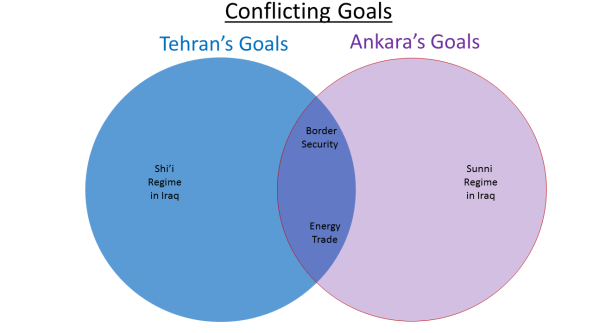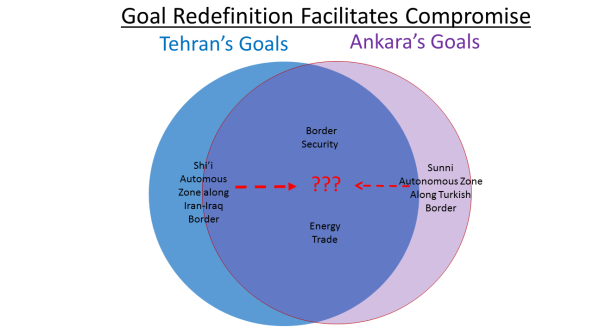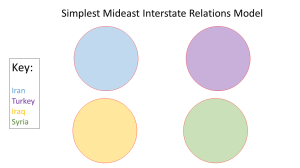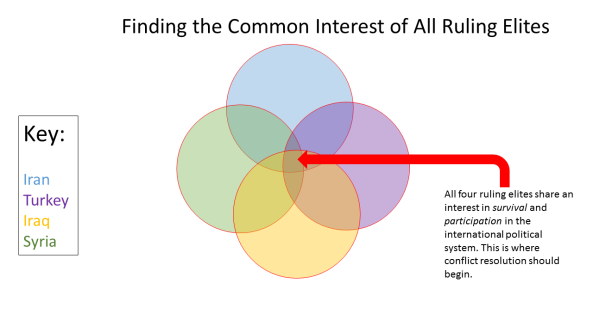While searching for positive-sum foreign policy offering enduring results (because they are supported by all sides) may be good advice for policy-makers, the process of designing such a policy is hindered by prejudice and emotion, [see “Designing Positive-Sum Foreign Policy“] not to mention incomplete information about the adversary and pressure from allies with private agendas. So a little formal modeling may spruce up the busy policy-maker’s thinking. It so happens that among all the many sophisticated techniques for analyzing international affairs there is one so straightforward that it really can be done with a pencil on a napkin…and this approach can quickly facilitate identifying some major foreign policy blunders and opportunities in contemporary Mideast affairs.
Far from being a naively idealistic dream, the search for positive-sum outcomes in foreign policy rests on a foundation of cold logic, a conclusion that may be easier to accept by using a very simple modeling technique whose magic, aside from its simplicity, is that to employ it naturally filters out emotion and prejudice, revealing the logical skeleton of truth. This old technique, that requires nothing more than a napkin and pencil, is the Venn Diagram. Let the foreign policy goals of State A be listed in one circle and those of State B in another, then see if any overlap exists. If so, diplomats have room to work. And, indeed, how can at least some overlap not exist? Do not all regimes wish to remain in power, do not all societies wish to survive? Perhaps not; suicidal political groups could exist, and if you judge that to be the case, then perhaps your model will contain two separate circles, and so be it…unless you choose to question the veracity of your model. More likely, by stating goals in general terms, e.g., the desire for security or development or prestige, ground for making deals will be discovered. The approach is rather more logical than just snarling that the adversary is “evil” or “crazy,” both characterizations conceivably true but almost certainly a source of confusion for a policy-maker trying to achieve something.
An initial Venn Diagram of Iranian-Turkish relations might show disagreement over the desired composition of a future Iraqi (or Syrian or Lebanese or Yemeni) regime but agreement on the goals of oil trading and border security. This logically flawed diagram should provoke an immediate protest: the defined goals are not on the same level, since the goals on which they agree are general (easy to agree on) while the conflicting goal (nature of the regime) is precise.

A “Mental Model” Based on Judgment of Iranian and Turkish Goals
Now comes time for creative diplomacy. Can the goals be redefined in a mutually acceptable manner to state that Turkey would like Sunni autonomy along its border while Iran would like Shi’i autonomy along its border? Their preferences, so stated, not only seem logical but feasible, given similar preferences on the part of many Iraqis actually living in those regions, changing the situation from an insolvable contradiction between Iraq’s two powerful neighbors into a reasonable proposal for shifting the Iraqi regime from centralized to decentralized with broad domestic and regional support.
By redefining the goals of Iraq’s two neighbors from trying to control Iraq, not their actual goal, to border security via empowerment of friendly populations, Ankara and Tehran can enhance their states’ security, please friendly Iraqi populations (further enhancing their security), and perhaps enhance the stability of Iraq, affording a long-term second-order benefit. The enlargement of the area of agreement in the foreign policy goals of the two states additionally promotes a cycle of cooperation that will facilitate cooperation on additional

Different but compatible goals…and a much less hostile relationship
issues after some delay as the leaders and bureaucracies on each side become increasingly accustomed to considering those on the other side as potential partners. The critical shift achieved by redefining the adversaries’ goals is to move them by making them more precise from mutually exclusive to different without being mutually exclusive, a process requiring no compromise–just a little creative thinking.
Nothing follows automatically from a diagram, of course. The red question marks in the center with arrows suggesting possible movement by each side toward a compromise solution signal where the real work of the diplomats will occur, but this work will be greatly facilitated by having a diagram that puts on paper the critical concept, all too often cast aside by prejudiced adversaries (especially those operating from a self-perceived position of strength), that a way forward can be imagined. If dismissed or not imagined, the positive-sum compromise that could resolve the conflict will not even be discussed.
Since the restructuring of the Iraqi government is the core issue under negotiation in this model, Iraq needs to be added to the model. Iraq’s role in conflict resolution is likely to be greatly influenced by both the Islamic State threat and the regional hydrocarbon trade regime envisioned by Ankara and Tehran.
The Islamic State, the latest incarnation of Sunni extremism and prime claimant to the Sunni dream of a restored caliphate, is also the latest challenger to the modern concept of international law. International law may be honored more in the breech than sincerely even by global leaders, but it is as close as the global political system comes to having an ideology to inform its interstate political structure. The Islamic State by its ideal of a caliphate and the open pride it takes in its terrorist behavior

A minimum of four states need to be incorporated in even the simplest Mideast model
(which in practice may only be slightly worse than the state terrorism practiced from time to time by numerous major states) challenges the global political system both on ideological and structural grounds. It is already central to the analysis of the foreign policies of Ankara, Tehran, Baghdad, and Damascus, four ruling factions but hardly any longer representing four real states. United by the pressure of the Islamic State, the four areas formerly constituting the states of Turkey, Iran, Iraq, and Syria seem the smallest analytical unit possible in the region for the realistic modeling of interstate relations.
Even this basic model of the Mideast, as riven by internal contradictions as it may be, is unified by the common desire of all ruling elites for survival. Yet, even at this simplest level, actual international behavior seems somehow to be missing the target. If all four want to survive, should this elemental fact not be better exploited to persuade them to compromise? A second fact is also obvious: all four want to participate. Nothing alienates a regime from the international community and transforms it into a troublemaker so surely as marginalization. By definition, he who rules desires to participate. Yes, the efforts to marginalize, by refusing to negotiate until after receiving a concession or by refusing to invite one player to a regional conference, are conscious efforts to exert pressure, but such blatant discrimination can hardly be expected to elicit sincerely accommodating attitudes. And yet, foreign policy failure, based on precisely this behavior, follows foreign policy failure. The four ruling parties share at least these two goals: survival and participation.
efforts to marginalize, by refusing to negotiate until after receiving a concession or by refusing to invite one player to a regional conference, are conscious efforts to exert pressure, but such blatant discrimination can hardly be expected to elicit sincerely accommodating attitudes. And yet, foreign policy failure, based on precisely this behavior, follows foreign policy failure. The four ruling parties share at least these two goals: survival and participation.
How might this knowledge be used? Consider the statement: “all regimes want to survive.” Once again, the precise formulation matters. To say, “all leaders want to survive” has the wrong focus – on individuals rather than groups, thus reducing room for negotiation, for it is much easier to accept the continued participation of a faction than a specific hated leader. There may well be members of the faction who legitimately represent a portion of the population and do not share the blame for all the leader’s crimes. In any case, the leader is the symbol. An international argument over the future of Assad will lead to war; an international argument over the continued participation of Alawites in Syrian politics is quite a different thing.
As for participation, no state will support an international system that rejects it. The international political system was incrementally, experimentally created by the regimes that existed to facilitate communication. To refuse to communicate evokes nothing so much as the spoiled brat who sulks in the corner: not appropriate behavior for the leader of the system! Such tactics are not calculated to inspire confidence, trust, or gratitude, nor should they: they are the epitome of insincerity. The tactical goal of regimes trying to create a better world should be to entice all actors who exist (unless indeed the intent is in fact to exterminate them) to participate, to communicate. This is the first step toward determining how to deal with them. So even as the model gets increasingly complicated (with the addition of more states and goals) in the effort to make it more realistic, it retains a simple yet valuable core: the region at the center–tiny as it may be–representing goals common to all is the point from which the design of foreign policy should begin.
Since all share some basic goals, negotiations have a place to begin. Can the area of agreement be enlarged? Could it be enlarged via creative redefinition of goals? Can discussions move smoothly from the core area of agreement to secondary goals amenable to compromise? One of the most valuable pieces of information to be gleaned from negotiations, even if one believes them to be “useless,” may be the identification of secondary goals of your adversary that turn out to be insignificant to you. Finding one is pure gold – something to offer that the adversary wants but you can readily give away. One glaring example in recent years has been U.S. refusal to extent diplomatic recognition to Iran, traditionally a nearly automatic diplomatic procedure that simply recognizes any power that exists but which was, in a major blunder, transformed by U.S. intransigence, into an additional unnecessary obstacle to resolving U.S.-Iranian conflict. valuable U.S. possession.
Having determined that the area of common interest exists but is small, the obvious next step is to identify ways to enlarge it, not necessarily with all other actors simultaneously but certainly in ways that try to avoid losing on one side what one gains on the other…at least until one determines that all out, unconditional warfare is the only solution. Aside from that very rare situation, negotiation should be pursued diligently – it is cheaper, safer, and can offer an endless array of unpredictable benefits if pursued with ears and eyes wide open because the political arena in the adversary’s camp will always be evolving in response to invisible domestic dynamics. If one puts on the table precise and credible offers impossible in today’s political environment for the adversary to accept, they may nonetheless become attractive without warning tomorrow. There is no telling, for example, what impact over time on Tehran’s support of Assad might result from a promise by Washington to support a post-settlement Iran-Syria or Iran-Turkey hydrocarbon pipeline, to support continued Alawite participation in a new regime, or to recognize the right of Iran to maintain close ties to the new regime. Indeed, the first option, i.e., the goal of economic development, may be the big goal omitted from our list of common goals, but its priority relative to sectarian conflict and the fear of being destroyed in civil war is uncertain, so it will be dealt with separately.


 efforts to marginalize, by refusing to negotiate until after receiving a concession or by refusing to invite one player to a regional conference, are conscious efforts to exert pressure, but such blatant discrimination can hardly be expected to elicit sincerely accommodating attitudes. And yet, foreign policy failure, based on precisely this behavior, follows foreign policy failure. The four ruling parties share at least these two goals: survival and participation.
efforts to marginalize, by refusing to negotiate until after receiving a concession or by refusing to invite one player to a regional conference, are conscious efforts to exert pressure, but such blatant discrimination can hardly be expected to elicit sincerely accommodating attitudes. And yet, foreign policy failure, based on precisely this behavior, follows foreign policy failure. The four ruling parties share at least these two goals: survival and participation.